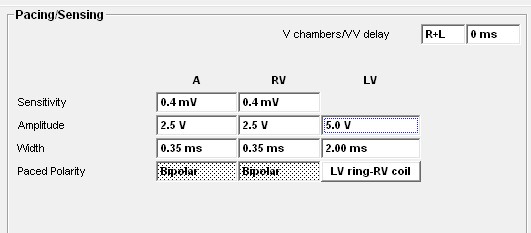Battery life
Case Summary
0 of 1 Questions completed
Questions:
Information
You have already completed the case before. Hence you can not start it again.
Case is loading…
You must sign in or sign up to start the case.
You must first complete the following:
Results
Results
Time has elapsed
Catégories
- Pas classé 0%
-
LV pacing leads are passively implanted (meaning without active fixation) into a coronary vein. Elevated thresholds are inherent to the technology since the lead is floating within a vein and paces the left ventricle on the epicardial side. This is one of the main reasons why today quadripolar leads are so popular (more choice in pacing vectors) and why left bundle branch pacing is taking the world by storm. In this patient implanted with a bipolar LV lead (as was the norm in 2009), the vector assistant reveals that any vector including the ring resulted in absolute lack of capture (no threshold found).
Only the vectors using the LV ring (to RV-coil or to can) resulted in capture but only at high output (4.5V) and maximal pulse widths (2 ms). Since the goal of CRT is to pace the heart at 100% and with the programmed pacing output of 5V @ 2 ms, there is considerable drain on the battery. In addition, forcefully a low margin of security of programmed pacing output, with high risk of intermittent loss of capture, compromising CRT efficacy.
In these cases there is most often (micro) dislodgement of the LV lead and placing of a new lead is recommended in most patients. It is important to review the first implantation notes to see what coronary venous anatomy the patient possesses and whether other location were previously attempted. If a traditional LV pacing approach is not possible through the coronary sinus, alternatives may include a surgical approach or bail-out using left bundle branch area pacing. In case of left bundle branch area pacing, pre-existing lead types (DF1, DF4, IS1, IS4) need to be taken into account since a IS-1 lead needs to be connected to the existing or new CRT-D device.
- 1
- Current
- Review / Skip
- Answered
- Exact
- Inexact
-
Question 1 of 1
1. Question
71-year old patient was implanted with a CRT-D (Platinium SonR) one year prior comes for a device check-up.
 Considering this device is one year old, the expected battery life of 1 year and 8 months is surprisingly short.
Considering this device is one year old, the expected battery life of 1 year and 8 months is surprisingly short.What is the reason for the short battery life?
ExactInexact



